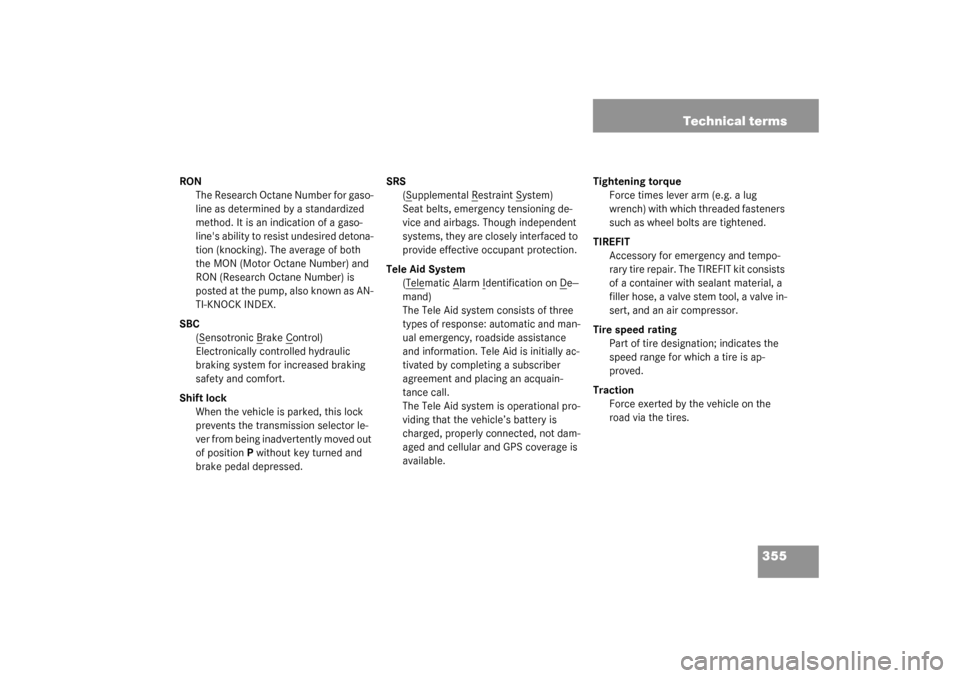Page 238 of 376

238 OperationTires and wheelsIf you wish to cancel activation:�
Press
ç
button.
If the following message appears in the
speedometer display field:
Reactivate tire press. monit.
�
Re-start the activation of the tire infla-
tion pressure monitor.
If the following message appears in the
speedometer display field:
Tire pressure
Check tires!
�
Re-start the activation of the tire infla-
tion pressure monitor.
Rotating wheels
On vehicles with the same wheel size all
around, wheels can be rotated every 3000
to 6000 miles (5 000 to 10 000 km), or
sooner if necessary, according to the de-
gree of tire wear. The same direction of tire
rotation must be retained.
Rotate the wheels before the characteris-
tic tire wear pattern becomes visible
(shoulder wear on front wheels and tread
center wear on rear wheels).Thoroughly clean the inner side of the
wheels after each rotation. Check and en-
sure proper tire inflation pressure, activat-
ing the tire inflation pressure monitor if
necessary. Warning!
G
Rotate front and rear wheels only if they are
of the same size.
Warning!
G
Have the tightening torque checked after
changing a wheel. Wheels could become
loose if not tightened with a torque of
96 ft.lb. (130 Nm).
Only use genuine Mercedes-Benz wheel
bolts specified for your vehicle's rims.
Page 318 of 376
318 Practical hintsFlat tireLowering the vehicle�
Lower vehicle by turning crank coun-
terclockwise until the full weight of the
vehicle is resting on the ground.
�
Pull the jack out of the jack support
tube.
1 - 5 Wheel bolts
�
Tighten the five wheel bolts evenly, fol-
lowing the diagonal sequence illustrat-
ed (1 to 5), until all bolts are tight.
Observe a tightening torque of 96 ft lb
(130 Nm).
�
Before storing the jack in the trunk,
crank back to storage position and fold
in the arm.Replacing jack support tube cover
�
Slide tongue of cover under the upper
edge of the tube opening.
�
Applying even pressure, press cover
until it snaps into place. Be careful not
to damage the locking tabs or clamp
the plastic retaining strap.
Warning!
G
Have the tightening torque checked after
changing a wheel. The wheels could come
loose if they are not tightened to a torque of
96 ft lb (130 Nm).
Page 355 of 376

355 Technical terms
RON
The Research Octane Number for gaso-
line as determined by a standardized
method. It is an indication of a gaso-
line's ability to resist undesired detona-
tion (knocking). The average of both
the MON (Motor Octane Number) and
RON (Research Octane Number) is
posted at the pump, also known as AN-
TI-KNOCK INDEX.
SBC
(S
ensotronic B
rake C
ontrol)
Electronically controlled hydraulic
braking system for increased braking
safety and comfort.
Shift lock
When the vehicle is parked, this lock
prevents the transmission selector le-
ver from being inadvertently moved out
of position P without key turned and
brake pedal depressed. SRS
(S
upplemental R
estraint S
ystem)
Seat belts, emergency tensioning de-
vice and airbags. Though independent
systems, they are closely interfaced to
provide effective occupant protection.
Tele Aid System
(Tele
matic A
larm I
dentification on D
e--
mand)
The Tele Aid system consists of three
types of response: automatic and man-
ual emergency, roadside assistance
and information. Tele Aid is initially ac-
tivated by completing a subscriber
agreement and placing an acquain-
tance call.
The Tele Aid system is operational pro-
viding that the vehicle’s battery is
charged, properly connected, not dam-
aged and cellular and GPS coverage is
available.Tightening torque
Force times lever arm (e.g. a lug
wrench) with which threaded fasteners
such as wheel bolts are tightened.
TIREFIT
Accessory for emergency and tempo-
rary tire repair. The TIREFIT kit consists
of a container with sealant material, a
filler hose, a valve stem tool, a valve in-
sert, and an air compressor.
Tire speed rating
Part of tire designation; indicates the
speed range for which a tire is ap-
proved.
Traction
Force exerted by the vehicle on the
road via the tires.